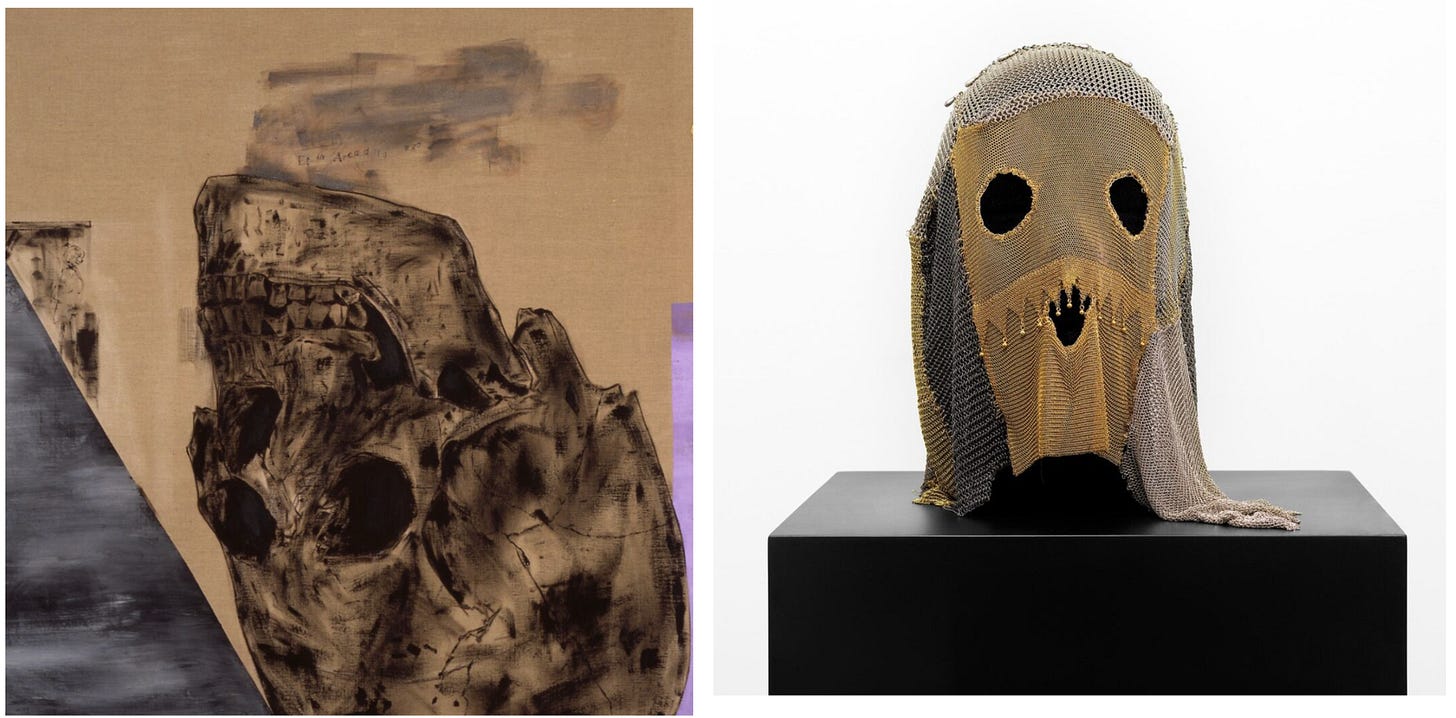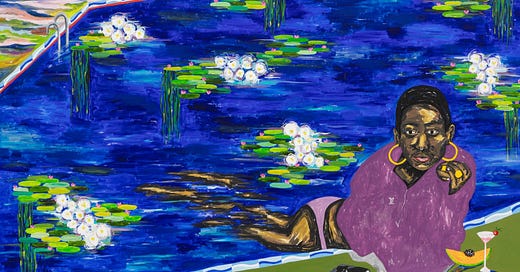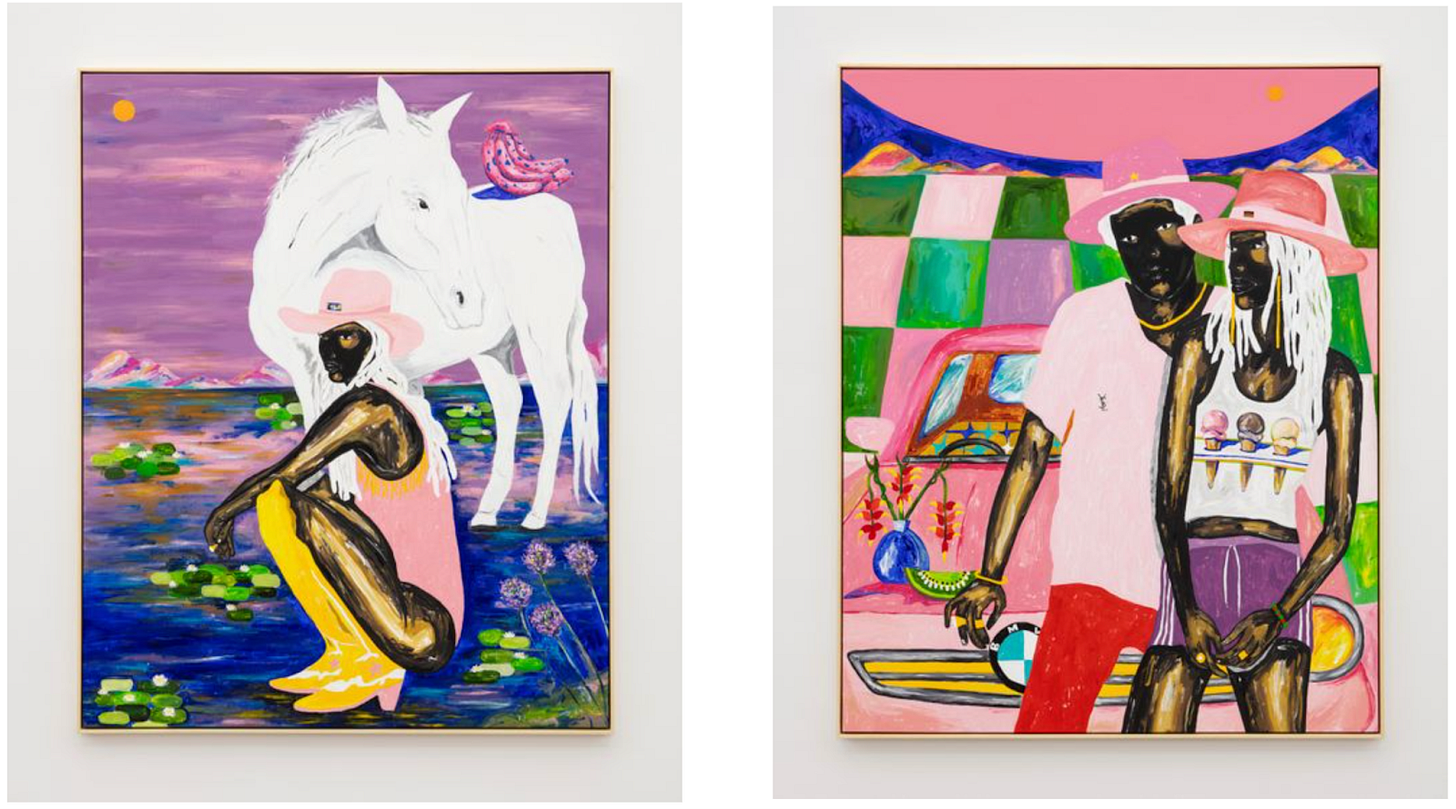Back to School for the Gallery Girlies
Brazilian color blasts, a painter who should forget printmaking, and haunting images of war (aka Palito, Guston, and Golub) !

There are a lot of good gallery shows up and running this fall — museum-quality works scattered across New York’s friendliest white cubes. Here are three to see, with some recommendations at the bottom.
Cars, Pools & Melanin by Zéh Palito at Perrotin closing October 19 (130 Orchard St)
This is one of my favorite shows I’ve seen in a long time — it’s cheeky, beautifully painted, brightly colored, and features a little art history treasure hunt. Zéh Palito (b. 1986) is a Brazilian artist living between a fruit farm outside of São Paolo and his studio in Baltimore. His paintings and their explanations feature a compelling balance between serious themes of racism and more lighthearted expressions of color and pleasure, and Palito successfully walks that delicate line. In a recent talk at the gallery, he explained the show’s title Cars, Pools & Melanin as a sort of road trip: a cross reference between American leisure, car culture, and the Green Book, a 20th century travel guide used by Black Americans to find restaurants and hotels where they’d be welcomed. The show’s 16 large paintings feature portraits of Black people lounging, as the title suggests, near cars or bodies of water. What ties it all together is his color scheme, wildly vibrant and rich and full of pinks, yellows and blues.
The color palette’s brightness isn’t just eye-catching but also highlights the skin tone of the figures, painted in shifting hues of brown and black. In The Inez “Pat” Patterson Water Lily Pond (2024), a woman crosses her arms and half-smiles at us over the edge of a swimming pool (that happens to be full of Monet’s water lilies — more on that shortly). The water’s rich murky blue shows up in nearly every painting, a counterbalance to the pink that’s often the other focal point. The blue is deep, mysterious, a little unknown, while the pink is an explosion of fervor and energy. Other color explosions include the yellow tracksuit of Summer Knights (2024) and the pink hoodie and matching car in Unbreakable (2024). The exuberance of these pinks and yellows feels particularly poignant when you remember the title. Palito doesn’t want you to forget that his figures, simultaneously proud and playful in their pools and fancy cars, are occupying spaces that were historically so inaccessible to Black people they needed a special guidebook to safely enjoy the most American of pastimes of all, the road trip.
One of things I find completely delightful about Palito’s paintings are the subtle nods to pop culture and art history embedded in each work. Some references are more obvious than others, like the Monet water lilies. Others are smaller. in The Starry Night at Lake Montebello (2024), a decidedly Beyonce-coded cowgirl takes a breather, lounging next to her white horse in a purple-pink landscape, a tiny Van Gogh Starry Night painted onto the front of her pink cowboy hat. In We Swam Against Their Waves (2024), a tank top with Wayne Thiebaud ice cream cones features next to a pink YSL t-shirt. My favorite is The Negro Splash (2024), a recreation of David Hockney’s 1967 pool scene A Bigger Splash, this time with a statuesque woman wearing a papaya-patterned swimsuit in the foreground, staring boldly out at us.
At the end of the day, Palito’s show is a chance to see work that’s somehow thoughtful and buoyant at the same time. The artist mentioned the inspiration he finds in Brazilian fruit — both from the fruit itself (start looking at the paintings and you’ll find papayas, melons, bananas everywhere, not to mention the show’s three large banana sculptures) but also in the generosity and abundance it represents. I’d say this love of fruit extends to his color scheme, too — looking at the colors of A Place in the Sun (2024) or The Starry Night at Lake Montebello (2024) feels a lot like cutting into a peach and marveling at its impossible brightness.
And bonus points for Perrotin being a dog-friendly gallery. Keep an eye out for Simone, a floopsy white mop who belongs to one of Perrotin’s gallerists and thinks this fall’s lineup is absolutely to die for, chérie…
Room, Sea & Sky by Philip Guston at Hauser & Wirth, closing October 26 (443 W 18th St)
Hauser and Wirth’s bookshop/small gallery space on 18th street has a room full of Gustons up until the end of October. The show, titled Room, Sea and & Sky, focuses on the famed painter’s lesser-known interest in printmaking. It’s always interesting to see how an artist known for one medium works in another, and I think in this case it’s safe to say that Guston made the right choice in sticking to painting.
The gallery claims the prints have “a physical presence that equals and at times rivals that of Guston’s large-scale paintings,” but this feels like some extreme hyperbole. It’s true that the black-and-white prints let you focus on Guston’s signature line, a mix of frantic movement and anxiety that radiates energy. And it’s powerful, for sure. Works like Sea Group (1980) and Pile Up (1980), with their fretful tangles of leg-like figures, show how important that energetic line is within Guston’s work. The prints with cyclops heads piled on top of each other, eye(s) rolling around with grotesque little hairs, are the best in the show.
But while his prints might be good, it's Guston’s paintings that are spectacular: moody, funny, thought-provoking, and in his trademark palette of pinks, blues and grays. At the end of the day, Guston is a color guy. Room, Sea & Sky features two paintings amid the prints, and that’s what you want to spend time with. The pepto bismol pinks of Aegean II (1977), both beautiful and nauseating, are what stick in your mind along with the rust reds and sky blue of Wall Forms and Blue Sea (1978). There’s a straightforward nature to Guston’s color choices, but seeing them in comparison with his black and white prints made me appreciate how refined the colors really are. So if you’re already a Guston fan, the show is worth seeing, and if not… try flipping through Robert Storr’s Guston: A Life Spent Painting in the Hauser & Wirth bookshop.
Leon Golub: Et In Arcadia Ego featuring Leon Golub and additional artists, conceived by Rashid Johnson at Hauser & Wirth, closing October 19 (542 W 22nd St)
At another Hauser & Wirth location, this one on 22nd st, you can find a very different kind of show. Guston might have a level of fretful anxiety around his work, but the works in Et in Arcadia Ego are more straightforwardly disturbing. Arcadia is all about war and conflict, and features the chaotic, earth-toned, menacing artworks you’d expect from a show about violence.
The exhibition centers around a group of huge paintings on jute linen by the artist Leon Golub (1922-2004), most 10 or 15 feet long. Golub’s focus throughout his career was on the suffering caused by war (he must have loved Käthe Kollwitz), and that focus is the jumping off point for the rest of the artworks featured in the show. Ranging from 2024 drawings of riot cops (Robert Longo) to chainmail masks made of “stainless steel, gold thread, and sweat” (Tiona Nekkia McClodden), to an abstract Philip Guston painting (there must be a H&W curator going through a Guston phase), there’s a lot to take in. The most upsetting is Zahra/Farah (2007) by Taryn Simon, which I won’t detail here, but needless to say it’s a heavy gallery visit.
The best works are Golub’s giant paintings, showing the artist’s mastery of the interaction between paint and canvas. With minimal strokes he uses the canvas like another type of paint, knowing exactly how to reveal the shading of a skull or a woman’s neck. His striking Napalm III (1969), 15 feet long and nearly 10 feet tall, shows two collapsing figures made of hellish fire. The rest of the tan linen is untouched, with the effect that the two figures seem trapped in eternal suffering — just insert your preferred war in the background. In a nutshell, get ready to feel deeply moved and unsettled. If you’re looking for fun or lightness, try staying on the ground floor of the gallery instead, which, in a complete vibe shift, currently features a series of “Duchampian readymade cars” (a car dealership, but make it aArRrtT).

There’s so much more to see. Surrealist Dorothea Tanning at Kasmin, San Francisco abstract artist Bernice Bing at Jerry Campbell, and pioneering Black cubist artist Jacob Lawrence at DC Moore — for next time!
All images courtesy of and with full rights to Perrotin and Hauser & Wirth galleries







